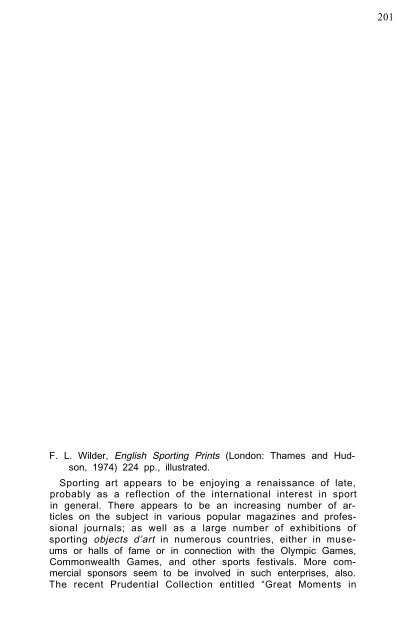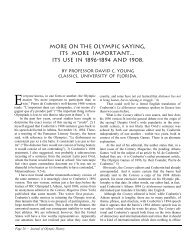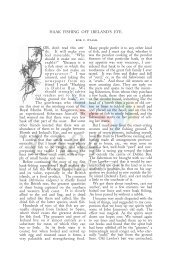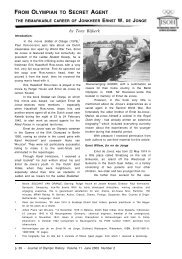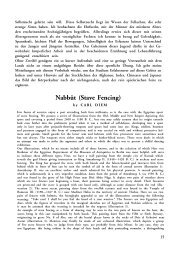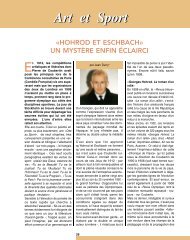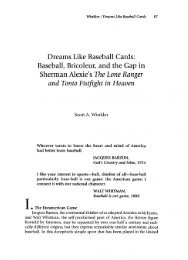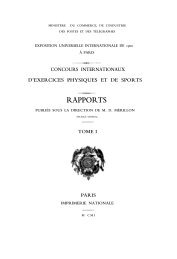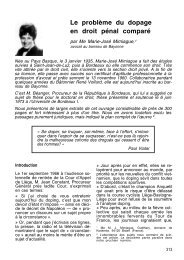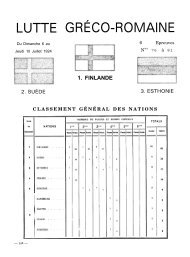Wilder, F.L. English Sporting Prints. (Book Review) - LA84 Foundation
Wilder, F.L. English Sporting Prints. (Book Review) - LA84 Foundation
Wilder, F.L. English Sporting Prints. (Book Review) - LA84 Foundation
Create successful ePaper yourself
Turn your PDF publications into a flip-book with our unique Google optimized e-Paper software.
F. L. <strong>Wilder</strong>, <strong>English</strong> <strong>Sporting</strong> <strong>Prints</strong> (London: Thames and Hudson,<br />
1974) 224 pp., illustrated.<br />
<strong>Sporting</strong> art appears to be enjoying a renaissance of late,<br />
probably as a reflection of the international interest in sport<br />
in general. There appears to be an increasing number of articles<br />
on the subject in various popular magazines and professional<br />
journals; as well as a large number of exhibitions of<br />
sporting objects d’art in numerous countries, either in museums<br />
or halls of fame or in connection with the Olympic Games,<br />
Commonwealth Games, and other sports festivals. More commercial<br />
sponsors seem to be involved in such enterprises, also.<br />
The recent Prudential Collection entitled “Great Moments in<br />
201
202<br />
Canadian Sport”, consisting of seventeen 12¾” x 16½” color<br />
prints, is but one prominent example.<br />
Another identifiable aspect of this movement is the recent<br />
willingness of publishers to reprint books in this area. William<br />
A. Baillie - Grohman’s significant work: Sport in Art:<br />
From the Fifteenth to the Eighteenth Century, first published<br />
in London in 1925, was re-issued by Benjamin Blom of New<br />
York in 1969. Similarly, Ralph Nevill’s Old <strong>Sporting</strong> <strong>Prints</strong> (first<br />
published in 1908) and Walter Shaw Sparrow’s British <strong>Sporting</strong><br />
Artists (first published in 1922), have both been reprinted between<br />
1965 and 1970 by Spring <strong>Book</strong>s. Sport historians should<br />
be grateful that such works are now readily available to them.<br />
The artist can often be a social historian, and the study of sporting<br />
art through the ages is a rewarding experience for anyone<br />
interested in the history of sport. Currier and Ives, for instance,<br />
made more lithographs during the second half of the<br />
nineteenth century than anyone else in America, and who can<br />
doubt that their colorful prints of famous athletic events in the<br />
United States during this period are worthy of attention?<br />
Most literary attention, however, has been devoted to the<br />
sporting prints of the United Kingdom, and F.L. <strong>Wilder</strong>’s 1974<br />
offering is the latest of this genre. <strong>English</strong> <strong>Sporting</strong> <strong>Prints</strong>, in<br />
fact, has some inherent virtues lacking in the other texts.<br />
Nevill’s book is certainly attractive and useful, but even more<br />
full of pictures of horses than such books tend to be. And not<br />
only horses but an abundance of coaches is evident as well<br />
(many of them in snow drifts). The classification of its contents<br />
- “List of Illustrations”, “Old <strong>Sporting</strong> <strong>Prints</strong>”, “List of Exceptionally<br />
Attractive <strong>Prints</strong>” and “A Record of the Principal<br />
<strong>Sporting</strong> <strong>Prints</strong> Sold by Auction, 1901-1908” - leaves a lot to be<br />
desired and is hardly inspiring or well organized. Sparrow’s<br />
work is much more comprehensive in nature and solid in detail,<br />
dealing with British sporting artists from Francis Barlow<br />
and his contemporaries in the seventeenth century to J. F.<br />
Herring and William Huggins in the nineteenth century. Chapters<br />
proceed chronologically according to the lives of the artists,<br />
an efficient and logical if somewhat uninteresting technique.<br />
Without a doubt, the analysis of the work and influence<br />
of such people as Peter Tillemans, John Wootton, and<br />
George Stubbs, give credence to the view of Sparrow’s work as<br />
“a classic critical survey of a specialized aspect of British art”.<br />
F. L. <strong>Wilder</strong> has taken a different approach in this latest publication<br />
and one that should appeal to sport historians. The organization<br />
of the book’s contents is pragmatic and useful. Perhaps<br />
the fact that the plates (all in color, incidentally) are classified<br />
according to the sport they depict is the most notable feature<br />
in this regard. The reader can find illustrations of the fol-
lowing sports in their appropriately labelled sections: Horses<br />
and Racing, Steeplechasing, Hunting, Shooting, Coursing, Fishing,<br />
Boxing, Fencing, Archery, Cricket, Billards, Ice skating, and<br />
Coaching. Alongside each plate is a description giving its title,<br />
artist, actual size, and the technique used (i.e. “mezzotint”,<br />
“coloured aquatint with etched outline”, etc.), and an historical<br />
analysis of the scene by the author. More often than not these<br />
literary portraits are good value, although many are too brief<br />
and one wishes that Mr. <strong>Wilder</strong> could have written more<br />
about several plates. Whenever possible the author has thoughtfully<br />
stated from which collection each plate is taken, and not<br />
surprisingly the majority belong to the outstanding Mellon<br />
<strong>Foundation</strong>.<br />
There is also an interesting section entitled “Processes”<br />
which explains the technique used for etching, soft-ground<br />
etching, aquatint, stipple-engraving, line-engraving, mezzotint,<br />
lithography, printing, and the coloring of prints. For<br />
readers who are ignorant of the technology involved to produce<br />
such elegant sporting prints, the details provided are most<br />
informative.<br />
Another section entitled “Reprints” has educational merit<br />
as the author informs us of the essential differences between<br />
first editions and reprints, and how to identify them. He has<br />
also provided “a list of most of the known examples” of reprints<br />
as a guide.<br />
The “Introduction”, of some fifteen pages, is an admirably<br />
condensed essay on the subject of <strong>English</strong> sporting prints and<br />
offers the reader many insights concerning the artists and their<br />
subjects, comments which indeed serve to bring the era to<br />
life. But the section which immediately follows, entitled<br />
“<strong>Sporting</strong> Writers”, is of limited value as it deals with only<br />
three: Charles James Apperley (who wrote under the pseudonym<br />
of “Nimrod”), Henry Hall Dixon, and Robert Smith Surtees.<br />
Any reader would obviously be better advised to consult A.<br />
Henry Higginson’s mammoth British and American <strong>Sporting</strong><br />
Authors (1951) for information on sporting writers of the<br />
period. The fact that <strong>English</strong> <strong>Sporting</strong> <strong>Prints</strong> does not include<br />
either a bibliography or index may be further cause for mild<br />
grievance. Certainly the production of the volume leaves<br />
nothing to be desired as it has been most handsomely printed<br />
in West Germany.<br />
The sporting print can record specific and memorable events<br />
in the sporting world in an aesthetic way which affords immediate<br />
and lasting pleasure. F. L. <strong>Wilder</strong>, who has been a specialist<br />
in sporting prints for more than fifty years, has provided here<br />
a personal and detailed history of the artists and printers who<br />
produced them in England during the eighteenth and nine-<br />
203
204<br />
teenth centuries; and recreates in a unique and useful manner<br />
an important time and place in the history of sport, Anyone<br />
interested in the relationship between sport and art cannot<br />
afford to be without this book.<br />
Gerald Redmond<br />
University of Alberta


